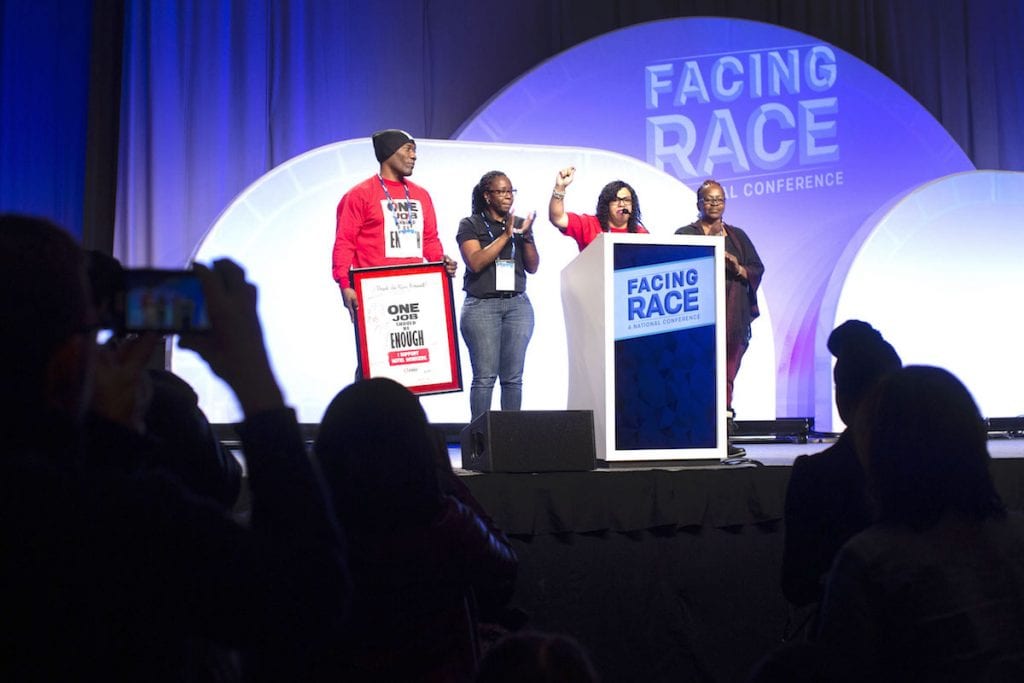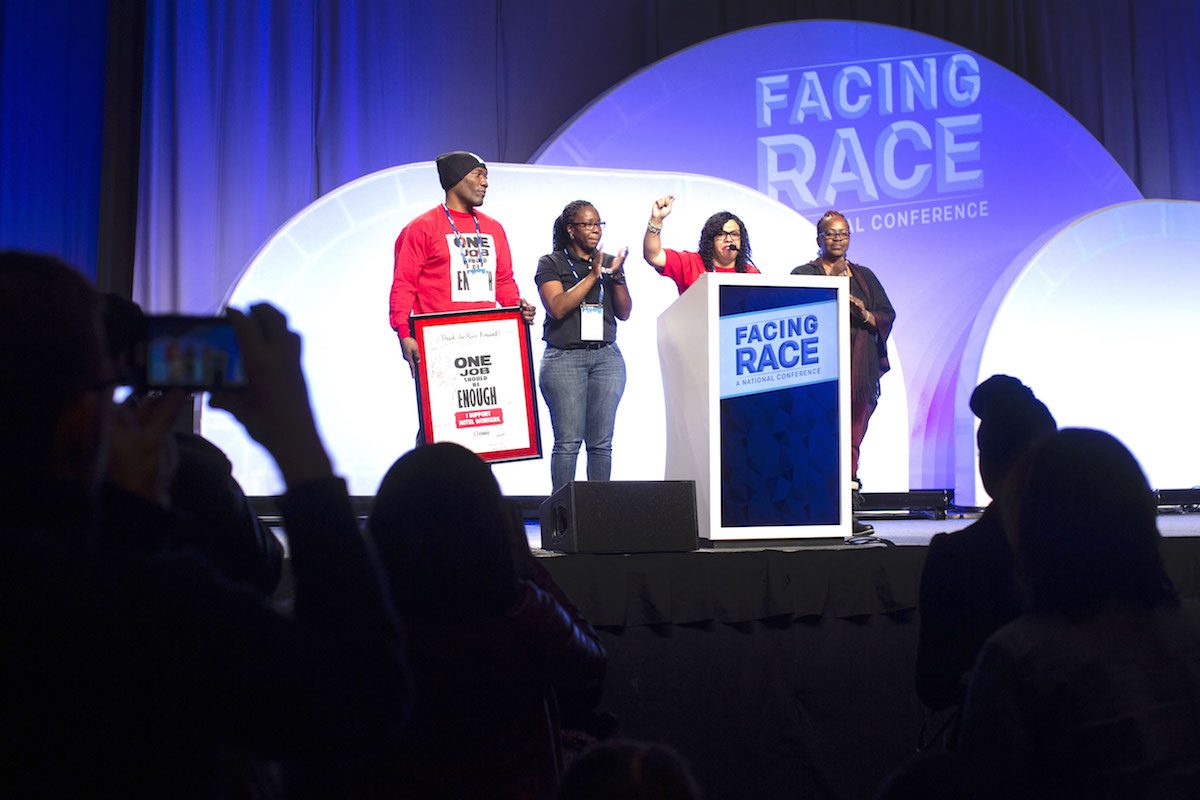
Workers at the Marriott-operated Westin Book Cadillac walked off the job to demand just economics and practices prior to the Facing Race Conference. Representatives from UNITE HERE! Local 24 Michigan/Ohio were invited to speak to the Facing Race crowd about the strike. Photo by Brian Palmer
Community benefits agreements (CBAs) are a familiar tool for many people who work in equitable development. A traditional community benefits agreement is worked out in relationship to a new development, for two reasons: first, to ensure that public incentives given to developers result in public benefits, and second, to mitigate the effects of a new development on the surrounding community. CBAs are generally negotiated between the developer and either a city or a set of community representatives. They can include a wide range of items, but common ones include local hire, local contracting, and living wage agreements; affordable housing provisions; and green space provisions.
Last November, Race Forward’s biannual conference Facing Race was held in Detroit, and I was intrigued to read in the conference program that the event had negotiated a CBA with local leaders.
After the conference, I spoke with Race Forward’s Leslie Grant-Spann to find out what it means to have a community benefits agreement for an event, and why it’s important to think about the local impacts of large events.
Miriam Axel-Lute: Tell me about where the idea to have a community benefits agreement for an event came from, and how it’s similar to or different from other kinds of community benefits agreements.
Leslie Grant-Spann: Race Forward was approached in January 2017 by a person named ill Weaver, who is a co-director of the Detroit Narrative Agency and a previous presenter and art exhibitor at Facing Race. [They said] “You know, there’s a lot of work that is happening here in Detroit, and we are becoming a destination place. These big national organizations come in, spend a ton of money, and oftentimes that money doesn’t reach communities. They’re not patronizing Detroit-based businesses, or Detroit-based businesses that are people-of-color-owned or -operated. And the intellectual properties of Detroiters gets extracted and put on this national stage, and we don’t get credit for it.”
They had established a community benefits agreements with an arts event that goes from city to city, and it was successful. And so they said that they wanted to continue to have that be a practice when dealing with national event-based programs. [Weaver said doing one with Race Froward was] an opportunity to be able to enter into nonthreatening negotiation processes with a group that has similar values to the folks in the city, specifically equity, social justice, human rights, and things of that nature.
Race Forward as an organization already had a very similar practice, in terms of how we produced our biannual Facing Race events. Who are the vendors that we source? What are the things that we’re integrating into our program, and the physical spaces that we create for people, to make them more accessible? How do we pay homage, and give honor, and uplift, highlight, and celebrate the work of the local cities that we’re doing our events in?
And so, we were like, “Oh, we didn’t know that there was a name for the thing that we were already doing.” And so we agreed to enter into the community benefits agreement. ill Weaver was the person who brought it to my attention, and then there were a number of other players—Halima Cassell, Shane Bernardo, dream hampton, adrienne maree brown. Those were the people who I first sat down with and had this conversation about officially formulating a community benefits agreement.
How were those folks selected?
Grant-Spann: They were self-selected, self-identified. These folks are all in community and relationship with each other. I think they had a conversation amongst themselves, because they’re all sponsored projects of Allied Media Projects.
[Also,] I had been doing outreach. Before Facing Race goes into a city, we do one-on-ones with folks who we have relationships with, and other folks introduce us to new folks who are doing work in a particular city. And we ask them: Do they see a benefit of the conference coming to the city? How can we use the conference as an opportunity to uplift, highlight, and promote the work that’s happening in a particular city? Is there any interest in being on our host committee? There are a number of job opportunities that get created via the production of the conference, and how can we advertise those to the local people? I probably did 70 one-on-ones going into Detroit before we actually agreed to produce the conference there.
So Race Forward has this practice already of thinking about these things. In what ways did formalizing the process take you farther? Was the CBA different than what you would have ended up with without this specific negotiation process?
Grant-Spann: It helped us to formalize our process internally as an organization. Now we have a container. We have a clear frame in which we can talk about the values that we have, and the way we aim to spend our resources, and invest in a particular city, and pay our respect, and make sure folks’ work is not being hijacked and co-opted, and things of that nature.
Before, we did it because those were the values that the planning team believed in, right? We come from community organizing backgrounds and are social justice activists, and the organization supported us, because it also shared those values with us. But entering into the Community Benefits Agreement has now helped us to institutionalize that practice. It won’t be dependent upon who’s producing the program now, because now there’s a clear language and frame for it.
So, when we talk about a CBA for a development, usually it’s partly “we want to make sure the benefits filter down,” but often, it’s also “we want to mitigate some of the harm that this development might be bringing,” whether that’s displacing some people from a building, or the construction, or additional traffic. Do people feel like there’s potential downsides to having these big events in the city, that need to be mitigated?
Grant-Spann: There is impact. Grassroots organizations don’t always appreciate national organizations coming into their cities, and potentially being in competition with them for funds. That’s usually the biggest thing that we hear: “OK, what are y’all doing to not interrupt the funds that we’re expecting to get from our local donors?” Because we come in, we have to fundraise a significant amount of money to put on the program, just to break even. Some groups don’t always appreciate that, right? They’re like, “Oh, y’all could draw from discretionary funds that we would have been able to tap.” So, that’s one of the things the CBA was able to mitigate.
Our thematic North Star is not to just be like, “Check out Race Forward. We’re super-awesome. We do all these things,” but it’s really to look up the racial justice work that’s happening in the city that we’re in, pay homage to that, and help people who come to that city learn about that city. And so, we leverage our platform to bring more donors in contact with the groups who are doing the work locally. We create spaces in the conferences for funders, potential funders, and local groups to interact and engage with each other.
And if there’s a major institution that gives money nationally and locally, we try to get that institution to underwrite the participation of the local people—sending all of their local grantees, or supporting the host committee to do a particular project or initiative, or underwrite a planning meeting, or scholarships for young people or underemployed folks. We always try to take those funds and turn them right back around and use them to support the city residents.
And you started this year, also, a series of grants to local organizing groups, right? Do you consider that part of the CBA or is that separate?
Grant-Spann: Yes. It definitely came from the formalization of the CBA. The Rinku Sen Innovation Award is $100,000 in one-time micro-grants given to grassroots organizations and groups in the city in which we will host the Facing Race conferences. That was a really clear-cut way for us to be able to show that we were about what we say we are.
As you indicated before, Race Forward has very similar values with the folks that you were arranging this with, as well as many local contacts, and other groups may not. Do you have recommendations for groups that might want to consider this, but might not have done as much work beforehand, or have as many contacts in a city?
Grant-Spann: Because of the sheer magnitude of the amount of resources that have to be poured into producing an event, there’s so much opportunity to do good by putting your money where your mouth is. An event like Facing Race generates almost a half a million dollars in economic activity. That money could be going into the hands of people-of-color-owned businesses, or businesses [whose] staff or leadership resembles the people who live in a particular community. It’s an opportunity for events-based programs to lean into their values.
I think a lot of people’s reactions might be “That sounds great, but (a) it’s going to take so much more work, and (b) it’s probably going to be more expensive.” What would you tell them?
Grant-Spann: The organization has to self-examine what their values are. To me, it’s no different than trying to have your event be green. It’s an investment. You have to learn how to do it. You find one lane, and you get in that lane, and you start to practice at it. And that’s kind of what the community benefits agreement could allow other groups to do. “OK, we’re going to spend $500,000 either way you go. Who do we want to spend our money with?”
It was not [always] easy. Detroit didn’t have particular industries as far developed, in terms of having POC [people of color] vendors who could service an event of our size, and that was a harsh reality for us. And we said, “Oh, crap. OK. What could we do? Well maybe, could we negotiate with the vendor around the labor teams?” You can encourage them to hire locally, to find you a foreman who’s a city resident. You can negotiate with your vendors to ensure that your resources are going to the people who live in the city, versus them flying in a foreman from California because “this is the best guy we’ve got.”
Even with our caterer we were like, “We want to purchase from Eastern Market.” “Oh, yeah, we purchase from this place, and that place.” “No. We want to purchase from X, Y, and Z, local folks who are doing urban farms,” to try to intentionally push the big vendor to cooperate with the smaller vendors to source the goods that we needed for our show. Those were the kind of power positions that any business can take, as part of a community benefits agreement.
We did everything that we could to make sure all of our utensils and our foodware was compostable and green, and we didn’t have water bottles. We had bubblers. And we pushed them not to source the water from Nestlé, because Nestlé is out of alignment with what the city is trying to accomplish around their water [justice] work.
It does make it harder, but it’s a worthwhile venture if you want your values to really shine through in your events.






Comments